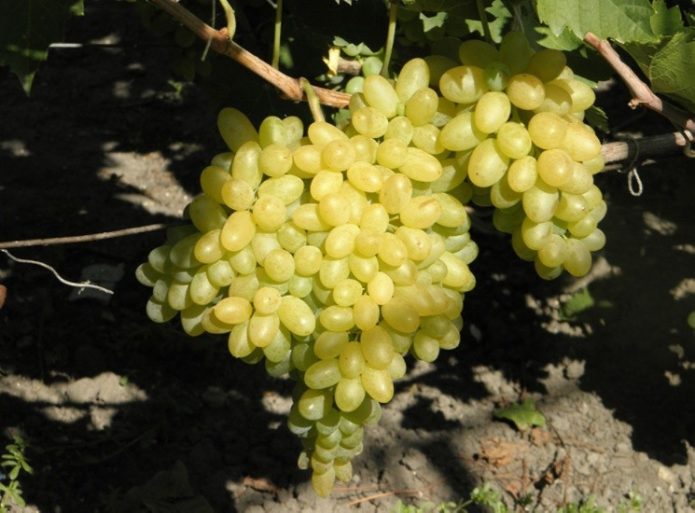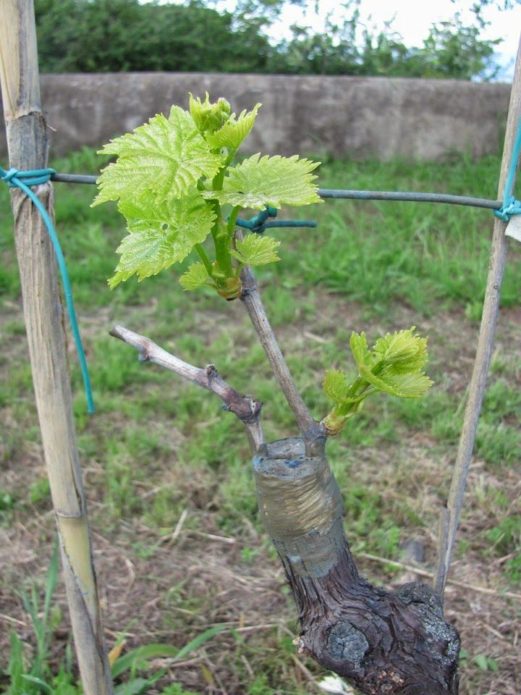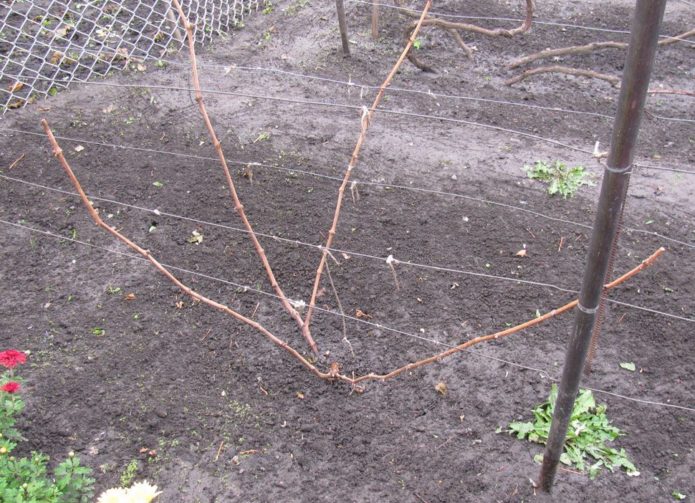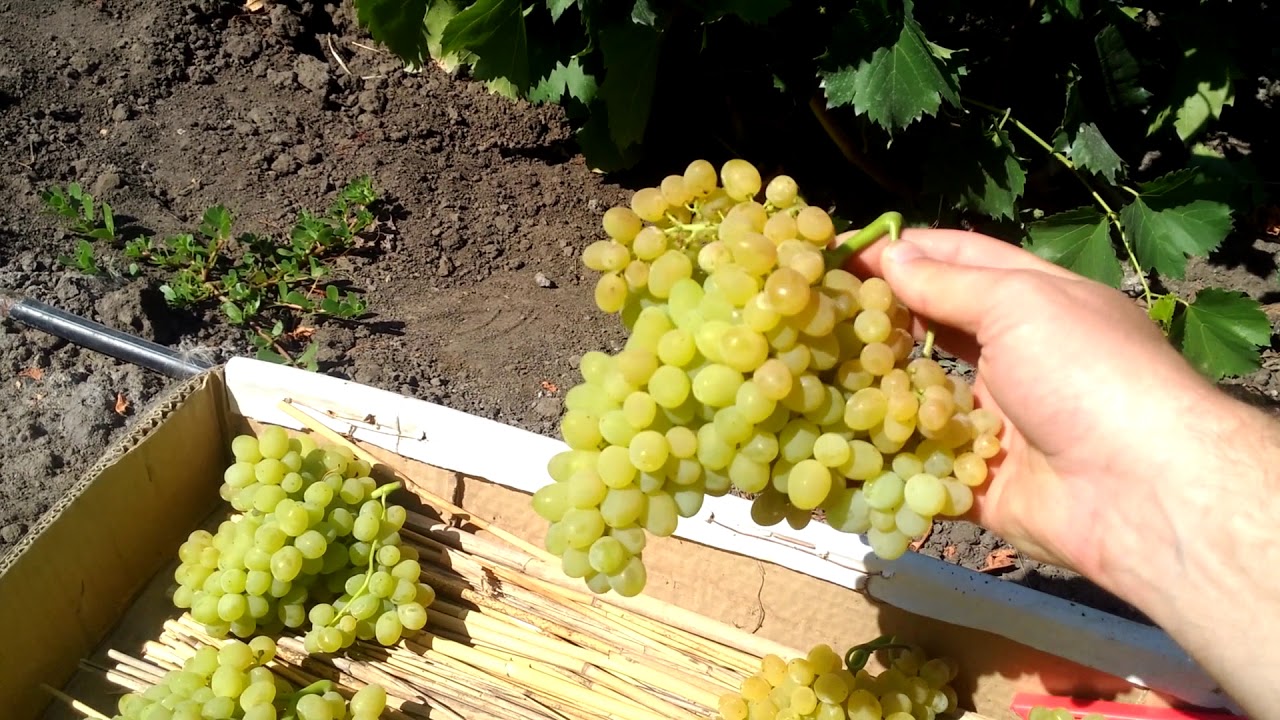Among the various grape varieties, the so-called raisin varieties stand out. Since raisins are pitted, they are ideal for making raisins. One of these varieties is Kishmish Century, new for Russian winegrowers, with beautiful large berries with a nutmeg aroma.
Content
Breeding history, description and characteristics of the Kishmish grape variety Century
Kishmish Centenary is an American variety that was bred more than thirty years ago and was originally named Centenel Sidlis. The work on its selection has been carried out for almost 20 years, in which the well-known grape varieties Gold and Q25-6 took part in them. The variety received official recognition in its homeland in 1980, and appeared in our country only 30 years later. However, he quickly earned the respect of both amateur winegrowers and professionals.
The literal translation of the name Centennail Seedless means "seedless century": grapes are really completely seedless. But why the Century?
Apparently, the creators believed that this raisin would be a kind of hit of the 20th century. After all, Americans are greedy for all the most-most!
Nevertheless, to some extent they were right: the variety quickly spread throughout the world, it is grown in both hemispheres of the globe. In our country, the Century is planted both in the south and in the central regions.
Bushes obtained from cuttings are distinguished by very high vigor. In this regard, despite the excellent survival rate of cuttings, the Century is more often propagated by grafting in order to limit the height of the bush and improve their resistance. Annual shoots ripen almost to the full length; as they become lignified, they acquire a dark brown color. The first bunches may appear as early as the second year after planting grapes; it enters full fruiting in the third or fourth year. The yield is annual, but not very high.
Cutting grapes - how to quickly and inexpensively update your garden:https://flowers.desigusxpro.com/en/yagody/vinograd/kak-razmnozhit-vinograd-cherenkami.html
Video: first grape harvest Century
The leaves are large, on long cuttings, have an emerald green color. The flowers are bisexual: no pollinator is required for this raisin. The big plus is that the variety does not require yield rationing. Ripening period is average: 120-125 days pass from budding to full ripeness of berries. Harvesting occurs in early or mid September.
Frost resistance of grapes is not bad: the limit of temperatures that it can withstand without shelter is about -23 aboutC. Medium resistance to most known diseases. Own-rooted bushes are not resistant to phylloxera.
Bunches are conical in shape, large, but varied in weight and size: on the bushes there may be medium-sized clusters (weighing about 400 g), and nearby - 1.5 kilogram specimens. There are no "peas" in them, the packing of berries is from medium-soft to dense. In conditions of good agricultural technology, ripe bunches can hang on the bushes for a long time.
The berries are large, oval in shape, about 3.0 x 1.6 cm in size, weighing from 6 to 9 g. The color is yellow-green, when fully ripe, the greenish tint disappears. Left on the bushes after full ripening, the berries can acquire an amber-yellow color with small brownish spots from the scorching sun. The skin is thin but firm and crispy. The berries lack even the rudiments of seeds.
The taste of seedless berries is harmonious, with a slight aroma of nutmeg: the sugar content (15-16%) and juice acidity (4-6 g / l) are balanced. It is believed that the taste of the berries is very similar to the well-known domestic variety Kishmish Radiant. Since the transportability of the crop is low, the variety belongs to local raisins: it is used for fresh consumption and for the production of raisins directly in the growing region. Berries can be kept on bushes for a long time also because they are not affected by birds and wasps.
Features of planting and growing grape varieties Kishmish Century
Kishmish Century cannot be considered an ideal variety in terms of cultivation: its agricultural technology has some nuances, and a beginner winegrower may find the variety somewhat capricious. It is unlikely that he will plant this variety on other bushes, he does not have them, as well as experience, so he will buy a ready-made seedling. And here the first problem will be: if a seedling is obtained from a cuttings of this variety, in a couple of years a huge bush will grow, difficult to care for. Experienced growers graft the Century on undersized phylloxera-resistant rootstocks.
Many gardeners find grafting a difficult task. This opinion is formed due to the fact that not everyone succeeds in the procedure the first time. If you carefully study this topic and follow all the rules, then a positive result will not be long in coming:https://flowers.desigusxpro.com/en/yagody/vinograd/privivka-vinograda-vesnoy.html
Planting a finished seedling is possible in autumn and spring, but in the middle lane it is better to do this in April. Planting practically does not differ from planting most grape varieties: a place is chosen sunny and protected from cold winds, a planting pit is prepared in advance. On clay soils, a hole has to be dug in sizes from 80 x 80 x 80 cm, on light soils it can be smaller. If planting is carried out near buildings, at least one and a half meters must be retreated from the foundation.
Drainage from rubble or any other similar material must be placed at the bottom. Above is a layer of fertilizer mixed with the soil, and a layer of clean, fertile soil. Fertilizers are one and a half buckets of compost, a liter can of ash and 300–400 g of azofoska. When planting, they try to do so that the roots of the seedling do not come into contact with fertilizers, especially mineral fertilizers. Two buds are left on the surface. A peg is immediately driven in for a garter of the growing shoot, but it is better to equip a strong trellis in advance for the future.
During the growing season, the bushes are watered about twice a month, the intensity depends on the weather. Do not water only during flowering and ripening. When planting, it is most convenient to provide for the arrangement of an irrigation pipe, leading it to the root zone, but on sandy soils, you can also water it in the usual way, into the planting hole. It is advisable that the water is not cold. Sprinkling is possible only in very hot weather to freshen the leaves. Excessive waterlogging is unacceptable: let the soil dry out better than stagnant water.
The grapes are fed with both organic and mineral fertilizers. Compost or humus is applied every two years (in early spring, two buckets are buried in small holes), complex mineral fertilizers can be given according to the instructions in the first half of summer, and as the berries grow, nitrogen fertilizers are excluded. Mineral fertilizers are very effective in the form of foliar dressing: by spraying foliage before flowering and immediately after it. And, at any time of the year, it will be useful to have ash scattered around the bush before watering.
Pruning is carried out several times. In early spring, before sap flow, you can do almost everything, but you need to be sure that it is still far from "crying". Otherwise, only dried shoots can be cut, and the main forming pruning grapes in autumn spend after falling leaves. Throughout the summer, barely appearing green shoots are broken out, growing not where the owner would like. Fortunately, the Centennial does not require crop rationing; all the bunches that have emerged can be left with it. But the thinning of berries in bunches at the pea stage can be done; for this, the lower part of the bunch is removed, which leads to the enlargement of the fruit.
In the fall, they examine the bush well, choose the best of the main shoots, leaving no more than eight of them. The shoots themselves are not cut off much: in this variety, the lower eyes are far from always fruitful, therefore, at least 8 buds are left on the shoots, and preferably 10-15. The total load on the bush should be 40–45 eyes. A century is almost always grown in a standard fan-shaped form, although some amateurs form it in the form of a tree.
Kishmish For a century, it is moderately resistant to diseases, therefore at least three preventive spraying is necessary. Especially often this grape gets sick with mildew. In early spring, the bushes are treated with iron vitriol, along a green cone with Bordeaux liquid, and in the phase of several leaves - with Horus or Ridomil Gold preparations. Phylloxera is the most dangerous for this variety, but it is very difficult to fight it. Treatment with carbon disulfide and other similar preparations not only kills the pest, but also greatly weakens the bush itself. Therefore, experts are trying to grow the Century on phylloxera-resistant stocks.
The frost resistance of the variety is at the level usual for modern varieties, therefore it is not sheltered for the winter only in the southernmost regions. Shelter in the middle lane requires light: after removing the vines from the trellises, they are wrapped in non-woven materials or spruce branches of coniferous trees are thrown on them. The grapes are opened in the spring with the arrival of warm weather.
Video: The best varieties of raisins
Advantages and disadvantages of the variety in comparison with similar
Grapes Kishmish Century - a universal purpose, which is its important difference from many similar varieties. It is suitable not only for making raisins, but also great when eaten fresh. It is distinguished from many kishmish varieties by its larger berries, among such varieties it is one of the record holders for seedlessness: even the presence of so-called rudiments - seed rudiments - is not noted in the berries. However, in order to obtain solid yields, it requires careful observance of all the rules of agricultural technology, including qualified pruning and mandatory preventive spraying.
In order for the grapes to grow healthy, you will have to dance with the sprayer around them quite often:https://flowers.desigusxpro.com/en/yagody/vinograd/chem-obrabotat-vinograd-vesnoy-ot-vrediteley-i-bolezney.html
The advantages of the variety include:
- stable, although not very high yield;
- evenness of berries in bunches with the absence of "peas";
- large size and high presentation of bunches and berries;
- complete absence of seeds;
- versatility of crop use;
- no need to remove part of the bunches;
- the safety of the crop on the bushes without cracking;
- crop resistance against wasps and birds;
- good frost resistance for American varieties.
The disadvantages of the Century grape variety include:
- poor transportability and low safety of the harvested crop;
- not very high yield;
- medium resistance to diseases and poor - to phylloxera;
- the need to thin out the bunches, without which the berries may not grow to their characteristic size.
Thus, Kishmish Century is a very good grape variety with a lot of advantages, but undesirable for growing as the first grape of a novice summer resident.
Reviews
One of the best commercial raisins. It bears fruit for 4 years. It ripens by 15–20 August. Stable crop, vigorous. Beautiful berries weighing 6–8 g, when processed with GK 9–11, dense, crispy, very harmonious taste, light nutmeg is not present every year. On sandy soils (I tried it with friends, a bush from our cutting), the taste is slightly different, the flesh is the same dense , was never watery. Requires 3, this year-4 treatments from mildew, from mildew usually treated 1 time, and this year one of the bushes was picked up, 2 treatments are needed, the defeat of gray. there was no rot. Hangs until frost! without loss of taste and is slightly affected by wasps.
The taste of the raisins of the Century is rather not nutmeg, but with the aroma of a tea rose, very delicate, original, unlike anything else.
Ksh Century this year started to soften a couple of weeks ago. When chewing the skin, a light nutmeg is already felt. The pulp is firm, there are no bones or rudiments. The skin is not felt when eating, it is tender. The berries do not burst or rot. The bunch is loose, beautifully executed.
I have a strong growth force of the Century, but I load it carefully, because the bunches-berries are large. Good condition and appearance are obtained with one cluster per shoot.
The Kishmish grape, which has recently taken root in our country, is already in steady demand among both experienced farmers and ordinary summer residents, since it has a lot of advantages. This is a variety whose berries are suitable for use in any form. And if in the middle lane it is not very easy to dry grapes for raisins, then its large seedless berries are perfectly eaten fresh. Well, in warm places in the sun, you get a wonderful large and even raisins.





